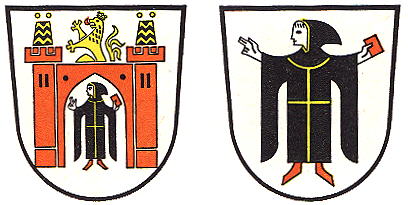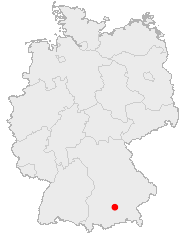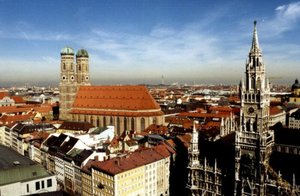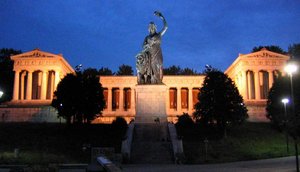Munich
|
|
Munich (German: München (pronounced Missing image
Ltspkr.png
listen) is the state capital of the German Bundesland of Bavaria. Behind Berlin and Hamburg, Munich is Germany's third largest city with a population of about 1.402 million (as of 2004). It is located on the river Isar, at Template:Coor dm. The city's motto is "Die Weltstadt mit Herz" (The world city with a heart).
| Contents |
History
| Coat of Arms | Map |
|---|---|

| 
|
The settlement was founded as Munichen in 1158 by Henry the Lion, Duke of Saxony, and half a century later it was granted city status and fortified. Initially, bishop Otto von Freising (Freising) and Henry quarreled about the city before the emperor at a Reichstag held in Augsburg. In 1180, with the trial of Henry the Lion, Otto of Wittelsbach became Duke of Bavaria. His Wittelsbach dynasty would rule Bavaria until 1918. In 1255, the dukedom of Bavaria was split in two, and Munich became the residence of Upper Bavaria.
In 1327, the entire city was destroyed by fire but was rebuilt some years later by Louis IV, the ruling Holy Roman Emperor of the time. In 1632 the city was occupied by Gustav II Adolph of Sweden during the Thirty Years' War and following 1705 it was under the control of the Habsburg family for some years. The city's first academic institution, the Bavarian Academy of Sciences, was founded in 1759.
By that time, the city was growing very quickly and was one of the largest cities in mainland Europe. In 1806, it became the capital of the Bavarian monarchical state, with the state's parliament (the Landtag) and the new archdiocese of Munich and Freising being located in the city. Twenty years later Landshut University was moved to Munich.
Many of the city's finest buildings belong to this period and were built under the reigns of the kings Ludwig I and Maximilian II. These buildings include the Ruhmeshalle and those on Ludwigstraße and Königsplatz, built by architects Leo von Klenze and Friedrich von Gärtner, and the "Bavaria" statue by Ludwig Michael von Schwanthaler.
In 1882 electric lighting was introduced to Munich, and the city hosted Germany's first exhibition of electricity. Nineteen years later the Hellabrunn Zoo opened in the city. After World War I, the city was at the center of much unrest. In November 1918, Communists took power establishing the Bavarian Soviet Republic (Münchner Räterepublik) which was put down on May 3 1919 by the right wing Freikorps, many of whom were later drawn to Adolf Hitler and National Socialism. In 1923 Hitler and his supporters, who then were concentrated in Munich, staged the Beer Hall Putsch, an attempt to overthrow the Weimar Republic and seize power. But the revolt failed, resulting in Hitler's arrest and the crippling of the Nazi Party, which was virtually unknown outside Munich. However, the city would once again become a Nazi stronghold when they took power in Germany in 1933. Because of its importance to the rise of Nazism, the Nazis called it Hauptstadt der Bewegung ("capital of the movement"). The NSDAP headquarters were in Munich and many Führerbauten ("Führer-buildings") were built around the Königsplatz, some of which have survived to this day.
In 1938, the Munich Agreement was signed in the city, ceding the mostly German speaking Sudetenland, previously a part of Czechoslovakia, to Germany. It was signed by representatives of Germany, Italy, France and Britain. A year later, in 1939, Georg Elser failed with his attempt to assassinate Hitler while the latter was giving his annual speech to commemorate the Beer Hall Putsch in the Bürgerbräukeller in Munich.
Munich was the city where the White Rose (German: Die Weiße Rose), a group of students that formed a resistance movement from June 1942 to February 1943, was based. The core members were arrested following a distribution of leaflets in Munich University by Hans and Sophie Scholl.
The city was very heavily damaged by allied bombing during World War II. After American occupation in 1945, Munich was completely rebuilt following a meticulous and, by comparison to other war-ravaged German cities, a rather conservative plan which preserved its pre-war street grid.
Munich was the site of the 1972 Summer Olympics, during which Israeli athletes were assassinated by Palestinian terrorists (see Munich massacre), where terrorist gunmen from the Palestinian "Black September" group took hostage members of the Israeli Olympic team. A rescue attempt by the West German government was unsuccessful and resulted in the deaths of the Israeli hostages, 5 of the terrorists, and one German police officer.
Several games of the 1974 Soccer World Cup were also held in the city and in 2006 it will again be host to several games, including the opening match of the next FIFA Soccer World Cup.
Sights
Theatiner_Kirche_Muenchen.jpg
Munich is a popular tourist destination and has been described as Germany's "second city".
The city has several important art museums, among them the Alte Pinakothek, Neue Pinakothek, and the Pinakothek der Moderne. Before World War I, it was also the site of the Blaue Reiter group of artists.
Other famous tourist attractions include the English Garden (Englischer Garten - a garden park roughly in the center of the city that contains a nudist area, jogging tracks and bridle-paths), the Deutsches Museum (Science Museum), and the Rathaus-Glockenspiel, an ornate clock with moving figures atop the town hall. Perhaps Munich's most famous attraction is the Oktoberfest, a 2-week-long fair with many rides and several very large tents. The Oktoberfest was first held October 12, 1810 in honor of the marriage of crown Prince Ludwig to Princess Therese von Sachsen-Hildburghausen. The festivities were closed with a horse race and in the following years the horse races were continued and later developed into what is now known as the Oktoberfest. Despite its name, Oktoberfest actually begins in September. It lasts two weeks and always finishes on the first Sunday in October.
Other famous buildings in Munich include the Frauenkirche ("Dom zu unserer Lieben Frau" - Cathedral of Our Lady) and the Olympiaturm ("Olympic Tower"), where visitors can be elevated on top. It is also an important radio and TV broadcasting station.
Mun_flags_frauenkirche.jpg
The Frauenkirche is the most famous building in the city center. This is Munich's central cathedral and is famous for its twin towers which are topped with brass minaret-type structures. At first glance the two towers appear to be the same height but in actual fact one is slightly taller than the other. Unlike most buildings in Munich's old town, the towers of the Frauenkirche (but not the church itself) survived the war intact, making them more than 400 years old. The Frauenkirche's towers (109 meters or 358 feet tall) are also the measurement for a new rule which limits the height of new buildings to the same height. This rule was passed in November 2004 by the people of Munich in a referendum ("Bürgerentscheid") organized by Georg Kronawitter, a former SPD mayor, against the will of the political parties in the city's parliament ("Stadtrat") who feared that it would harm the city's attractiveness to investors.
The Olympiaturm (Olympic Tower) and the Olympic Park with its stadium was built for the 1972 Summer Olympics which were held in Munich. The Olympic buildings are famous for their design, which was inspired by dew-covered cobwebs.
The 2006 World Cup, however, will not take place in the traditional Olympic Stadium, but in Munich's new soccer stadium, the Allianz Arena.
BMW_building_munich.jpg
Buildings
Around Munich
Lying on the plain of the Voralpenland, the Munich agglomeration sprawls unhindered by geography. Several smaller traditional Bavarian cities are today part of the Munich suburbia and are worth a visit when the main Munich sights are exhausted.
Sights
- Schloß Nymphenburg (Nymphenburg castle)
- Schloß Oberschleißheim (Oberschleissheim castle)
Economy
Munich was one of the centers of the new economy in Germany, and remains to be a centre for biotechnology, programming and Internet companies in Germany. The city is home to the global headquarters of German insurance companies Allianz AG and Münchener Rück, the car manufacturer BMW, the technology firms Siemens AG and Infineon Technologies, as well as the German headquarters of McDonald’s and Microsoft. In addition to this, Munich is home to a big number of publishing houses, worldwide second only to New York City.
Lifestyle
Residents of Munich enjoy a high quality of life. Mercer HR Consulting consistently rates the city among the top 10 cities with highest quality of life worldwide. The 2005 survey rated Munich as 5th. Munich enjoys a thriving economy - principally information technology, biotechnology, and publishing. Environmental pollution is low, although currently the city is concerned about levels of fine dust in the air. The public transport is extremely efficient, although delays on the S-Bahn (light commuter trains) often cause frustration during extreme winter weather. The crime rate is very low and personal safety is high. This high quality of life and safety has caused the city to be nicknamed a "Toytown" - particularly amongst the English speaking residents.
Nightlife is thriving. There are over 6,000 licensed establishments in the city. Cafe culture is strong in Munich, especially during the summer of course. There are many restaurants accommodating all preferences of cuisine. And possibly the most important free time activity during the summer: the beer gardens. There are around 20 major beer gardens with four of the most famous and popular being located in the Englischer Garten - the largest city park in Europe.
Miscellaneous
Munich's current mayor is Christian Ude of the SPD (Social-democratic Party of Germany), and Munich has a nearly unbroken history of SPD governments since World War II. This is extraordinary because the rest of Bavaria is a conservative stronghold, with the CSU (Christian Social Union) winning absolute majorities among the Bavarian electorate in nearly all elections communal, state and federal level.
The figure on Munich's coat-of-arms is the Münchner Kindl, the child of Munich (a monk).
Transportation
Munich airport, named after Franz Josef Strauß, is Franz Josef Strauß International Airport. The airport can be reached by suburban train lines S1 and S8. Its international three-letter code is "MUC".
Munich has a large public transport system including Subways, Suburban trains, trams and buses. The local transportation is supervised by the Munich Transport and Tariff Association (Münchner Verkehrs- und Tarifverbund (http://www.mvv-muenchen.de/en/index.html)).
Colleges and universities
- Ludwig-Maximilians-Universität München (LMU), founded in 1472 in Ingolstadt, moved to Munich in 1826
- Technical University of Munich (TUM), founded in 1868
- Munich University of Applied Sciences (FHM), founded in 1971
- Universität der Bundeswehr München, founded in 1973
- Hochschule für Musik und Theater München, founded in 1830
- Akademie der Bildenden Künste München, founded in 1808
- Hochschule für Fernsehen und Film , founded in 1966
- Hochschule für Philosophie München, founded in 1925 in Pullach, moved to Munch in 1971
- Hochschule für Politik München
- Katholische Stiftungsfachhochschule München, founded in 1971
- Munich Business School (MBS)
- European School of Management and Technology (esmt)
- Max Plank Institute Garching
- Fraunhofer Institute
Sister cities
- Bordeaux, since 1964
- Cincinnati, since 1989
- Edinburgh, since 1954
- Harare, since 1996
- Kyiv, since 1989
- Sapporo, since 1972
- Verona, since 1960
External links
- The city's own website. (http://www.muenchen.de/)
- The Oktoberfest (http://www.oktoberfest.de/) with information in both English and German
- Photos (http://www.travel-impressions.de/munich/muenchen.htm) of Munich, Sights, Daily Life, Oktoberfest, etc.
- Munich travel guide at Wikitravel (http://wikitravel.org/en/article/Munich)
- Lonely Planet guide to Munich (http://www.lonelyplanet.com/destinations/europe/munich)
- Toytown Munich - a community Website about Munich (http://www.toytownmunich.com/)
bg:Мюнхен cs:Mnichov da:München de:München et:München es:Múnich eo:Munkeno fa:مونیخ fr:Munich gl:Múnic - München ko:뮌헨 id:München it:Monaco di Baviera he:מינכן ku:München la:Monachium nl:München nds:München ja:ミュンヒェン nb:München nn:München pl:Monachium pt:Munique ro:München ru:Мюнхен simple:Munich sk:Mníchov fi:München sv:München ta:மியூனிக் th:มิวนิก vi:München uk:Мюнхен zh:慕尼黑



